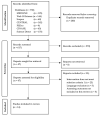Effects of Low-Load Blood Flow Restriction Resistance Training on Muscle Strength and Hypertrophy Compared with Traditional Resistance Training in Healthy Adults Older Than 60 Years: Systematic Review and Meta-Analysis
- PMID: 36556004
- PMCID: PMC9787798
- DOI: 10.3390/jcm11247389
Effects of Low-Load Blood Flow Restriction Resistance Training on Muscle Strength and Hypertrophy Compared with Traditional Resistance Training in Healthy Adults Older Than 60 Years: Systematic Review and Meta-Analysis
Abstract
Background: There is clinical interest in determining the effects of low-load blood flow restriction (LL-BFR) resistance training on muscle strength and hypertrophy compared with traditional high- and low-load (HL and LL) resistance training in healthy older adults and the influence of LL-BFR training cuff-pressure on these outcomes.
Methods: A search was performed on the MEDLINE, PEDro, CINHAL, Web of Science, Science Direct, Scopus, and CENTRAL databases.
Results: The analysis included 14 studies. HL resistance training produces a small increase in muscle strength (eight studies; SMD, -0.23 [-0.41; -0.05]) but not in muscle hypertrophy (six studies; (SMD, 0.08 [-0.22; 0.38]) when compared with LL-BFR resistance training. Compared with traditional LL resistance training, LL-BFR resistance training produces small-moderate increases in muscle strength (seven studies; SMD, 0.44 [0.28; 0.60]) and hypertrophy (two studies; SMD, 0.51 [0.06; 0.96]). There were greater improvements in muscle strength when higher cuff pressures were applied versus traditional LL resistance training but not versus HL resistance training.
Conclusions: LL-BFR resistance training results in lower muscle strength gains than HL resistance training and greater than traditional LL resistance training in healthy adults older than 60 years. LL-BFR resistance training promotes a similar muscle hypertrophy to HL resistance training but is greater than that of traditional LL resistance training. Applying cuff pressures above the limb occlusion pressure could enhance the increases in muscle strength compared with traditional LL resistance training.
Keywords: aged; blood flow restriction therapy; healthy people programs; human physical conditioning; musculoskeletal physiological phenomena; review.
Conflict of interest statement
The authors declare no conflict of interest.
Figures



Similar articles
-
Effects of Blood Flow Restriction Training on Muscle Strength and Hypertrophy in Untrained Males: A Systematic Review and Meta-Analysis Based on a Comparison with High-Load Resistance Training.Life (Basel). 2024 Nov 7;14(11):1442. doi: 10.3390/life14111442. Life (Basel). 2024. PMID: 39598240 Free PMC article. Review.
-
Muscle strength adaptation between high-load resistance training versus low-load blood flow restriction training with different cuff pressure characteristics: a systematic review and meta-analysis.Front Physiol. 2023 Aug 25;14:1244292. doi: 10.3389/fphys.2023.1244292. eCollection 2023. Front Physiol. 2023. PMID: 37693006 Free PMC article.
-
Effects of Blood Flow Restriction Training on Muscular Strength and Hypertrophy in Older Individuals: A Systematic Review and Meta-Analysis.Sports Med. 2019 Jan;49(1):95-108. doi: 10.1007/s40279-018-0994-1. Sports Med. 2019. PMID: 30306467 Free PMC article.
-
Acute cellular and molecular responses and chronic adaptations to low-load blood flow restriction and high-load resistance exercise in trained individuals.J Appl Physiol (1985). 2021 Dec 1;131(6):1731-1749. doi: 10.1152/japplphysiol.00464.2021. Epub 2021 Sep 23. J Appl Physiol (1985). 2021. PMID: 34554017
-
Effects of Low-Load Blood Flow Restriction Training on Muscle Anabolism Biomarkers and Thrombotic Biomarkers Compared with Traditional Training in Healthy Adults Older Than 60 Years: Systematic Review and Meta-Analysis.Life (Basel). 2024 Mar 20;14(3):411. doi: 10.3390/life14030411. Life (Basel). 2024. PMID: 38541735 Free PMC article. Review.
Cited by
-
Exploring Blood Flow Restriction Exercise Protocols for Elderly Populations: A Scoping Review of Cuff Pressure, Frequency, and Duration for Muscle Strength, Hypertrophy, and Functional Abilities Outcomes.J Clin Med. 2025 Jun 12;14(12):4185. doi: 10.3390/jcm14124185. J Clin Med. 2025. PMID: 40565940 Free PMC article. Review.
-
The Effects of Blood Flow Restriction Exercise on Muscle-Brain Crosstalk: A Systematic Review.Muscles. 2025 Jun 19;4(2):19. doi: 10.3390/muscles4020019. Muscles. 2025. PMID: 40757562 Free PMC article. Review.
-
Effect of blood-flow restricted vs heavy-load resistance training on strength, power, and speed for healthy volunteers: a systematic review and meta-analysis.PeerJ. 2025 Mar 18;13:e19110. doi: 10.7717/peerj.19110. eCollection 2025. PeerJ. 2025. PMID: 40124607 Free PMC article.
-
The Safety of Blood Flow Restriction Combined with Stepping Aerobic Exercise in Older Adults with Sarcopenia.Clin Interv Aging. 2025 Aug 6;20:1165-1179. doi: 10.2147/CIA.S520775. eCollection 2025. Clin Interv Aging. 2025. PMID: 40787252 Free PMC article.
-
Effects of upper extremity blood flow restriction training on muscle strength and hypertrophy: a systematic review and meta-analysis.Front Physiol. 2025 Jan 6;15:1488305. doi: 10.3389/fphys.2024.1488305. eCollection 2024. Front Physiol. 2025. PMID: 39835205 Free PMC article.
References
-
- World Health Organization . Ageing and Health. World Health Organization; Geneva, Switzerland: 2021.
Publication types
LinkOut - more resources
Full Text Sources

